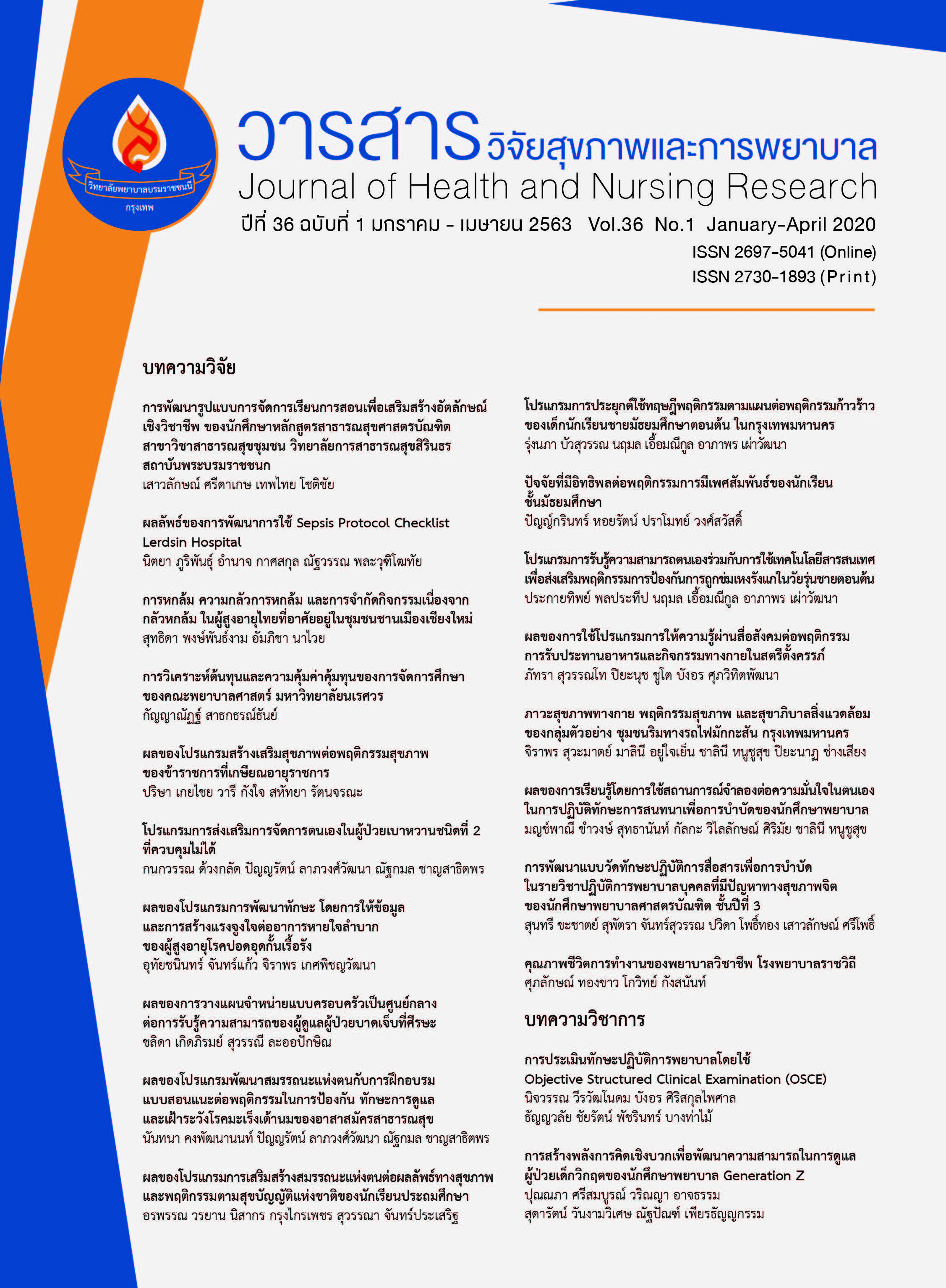ผลลัพธ์ของการพัฒนาการใช้ Sepsis Protocol Checklist Lerdsin Hospital
คำสำคัญ:
กลุ่มอาการโรคภาวะเหตุพิษติดเชื้อ, แนวทางปฏิบัติ, ผลลัพธ์การดูแลที่เป็นเลิศบทคัดย่อ
การศึกษาวิจัยแบบตัดขวาง มีวัตถุประสงค์เพื่อศึกษาผลลัพธ์การพัฒนาระบบการพยาบาลผู้ป่วยโรคภาวะพิษเหตุติดเชื้อ (sepsis) ก่อนและหลังการใช้แนวทางการดูแลแบบ Sepsis Protocol checklist Lerdsin Hospital กลุ่มตัวอย่างเป็นผู้ป่วยที่มีอายุ 15 ปีขึ้นไป ที่มารับการรักษาในแผนกอุบัติเหตุและฉุกเฉิน ได้รับการวินิจฉัยว่ามีภาวะเหตุพิษติดเชื้อโดยมีการบันทึกข้อมูลครบถ้วนในแบบบันทึก Sepsis Protocol checklist Lerdsin Hospitalจากการคำนวณตามสูตรได้กลุ่มตัวอย่างจำนวน 70 คน ในการเก็บรวบรวมข้อมูลการวิจัยครั้งนี้ใช้กลุ่มตัวอย่างจำนวน 140 คน โดยคัดเลือกจากผู้ป่วยที่ได้รับการรักษาตามเกณฑ์การคัดเข้า และเลือกกลุ่มตัวอย่างแบบสะดวก วิเคราะห์ข้อมูลโดยสถิติเชิงพรรณนา เพื่ออธิบายข้อมูลส่วนบุคคลของกลุ่มตัวอย่างและใช้สถิติ Chi-square วิเคราะห์ผลลัพธ์ทั้ง 7 ด้านเปรียบเทียบก่อนและหลังการใช้แนวทางปฏิบัติ กำหนดระดับนัยสำคัญทางสถิติที่ระดับ .05
ผลการวิจัยพบว่าการใช้แนวทางการดูแลผู้ป่วยโรคภาวะเหตุพิษติดเชื้อทั้ง 7 ด้าน ส่งผลทำให้มีผลลัพธ์ที่ดีขึ้นในทุกขบวนการดูแลอย่างมีนัยสำคัญทางสถิติที่ระดับ .05 และ .001 และจำนวนวันนอนโรงพยาบาลลดลงจาก 11.40 วัน เป็น 11.17 วัน อย่างมีนัยสำคัญทางสถิติที่ .146 รวมถึงผู้ป่วยมีอาการดีขึ้นสามารถจำหน่ายกลับบ้านได้เพิ่มขึ้นจาก ร้อยละ 58.60 เป็นร้อยละ 82.90 และพบว่าผู้ป่วยมีอัตราการเสียชีวิตลดลงจากร้อยละ 41.40 เหลือร้อยละ 17.10 อย่างมีนัยสำคัญทางสถิติที่ .05
Downloads
เอกสารอ้างอิง
2. Song Y, Shin T, Jo I, Jeong Y, Kang M, Sim M, et al. 54 Predicting factors associated with clinical deterioration of sepsis patients with intermediate levels of serum lactate. Ann Emerg Med. 2012;4(60):S21–2.
3. Vosylius S, Sipylaite J, Ivaskevicius J. Sequential organ failure assessment score as the determinant of outcome for patients with severe sepsis. Croat Med J. 2004;45(6):715–20.
4. Huang DT, Clermont G, Dremsizov TT, Angus DC, Investigators P. Implementation of early goal-directed therapy for severe sepsis and septic shock: a decision analysis. Crit Care Med. 2007;35(9):2090–100.
5. Martin GS, Mannino DM, Eaton S, Moss M. The epidemiology of sepsis in the United States from 1979 through 2000. N Engl J Med. 2003;348(16):1546–54.
6. Finfer S, Bellomo R, Boyce N. A comparison of albumin and saline for fluid resuscitation in the intensive care unit. N Engl J Med. 2004;350(22):2247–56.
7. Pittet D, Rangel-Frausto S, Li N, Tarara D, Costigan M, Rempe L, et al. Systemic inflammatory response syndrome, sepsis, severe sepsis and septic shock: incidence, morbidities and outcomes in surgical ICU patients. Intensive Care Med. 1995;21(4):302–9.
8. Arise D. The outcome of patients with sepsis and septic shock presenting to emergency departments in Australia and New Zealand. Crit Care Resusc. 2007;9:8–18.
9. Angkasekwinai N, Rattanaumpawan P, Thamlikitkul V. Epidemiology of sepsis in Siriraj Hospital 2007. J Med Assoc Thai. 2009;92 (Suppl 2):S68-78. (in thai)
10. Wirotwanit N. The Effectiveness of Implementing the Nurse Practice Guideline among Patients with Sepsis at Emergency Department, Naresuan University Hospital. J Nurs Heal Sci. 2018;12(1):84–94. (in Thai).
11. Lundberg JS, Perl TM, Wiblin T, Costigan MD, Dawson J, Nettleman MD, et al. Septic shock: an analysis of outcomes for patients with onset on hospital wards versus intensive care units. Crit Care Med. 1998;26(6):1020–4.
12. Pichai C. Factors for Mortality of Bacteremia in Surin Hospital Title. Buddhachinaraj Med. 2007;24(1):33–45. (in Thai).
13. Picard KM, O’Donoghue SC, Young-Kershaw DA, Russell KJ. Development and implementation of a multidisciplinary sepsis protocol. Crit Care Nurse [Internet]. 2006 Jun;26(3):43–54. Available from: https://pubmed.ncbi.nlm.nih.gov/16717386
14. Rivers E, Nguyen B, Havstad S, Ressler J, Muzzin A, Knoblich B, et al. Early goal-directed therapy in the treatment of severe sepsis and septic shock. N Engl J Med. 2001;345(19):1368–77.
15. Chirawatkul A. Statistics for Health Science Reseaech. 4th ed. Wittayapat, Bangkok 2015. (in Thai).
16. Mahantassanapong C. Outcome of the Surin Sepsis Treatment Protocol in Sepsis Management. Srinagarind Med J. 2012;27(4):332–9. (in Thai).
17. Komon P, Namjuntra R, Binhosen V. Quality of care management in Persons with Sepsis Syndrome at emergency department in Singburi Hospital. APHEIT Int. 2017;2(2):32–43. (in Thai).
18. Nueng Nasuwan W, Normkusol J, Thongjam R, Panaput T. Development of the nursing service system for patients with severe sepsis. J Nurs Heal Care. 2014;32(2):25–36. (in Thai).
19. Onswadipong P, Sungkard K, Ayuthya SKN, Rongrungruan Y. The effect of early goal-directed nursing intervention on severity of organ failure in patients with sepsis syndrome. Nurs Sci J Thail. 2011;29(2):102–10. (in Thai).
20. Levy MM, Dellinger RP, Townsend SR, Linde-Zwirble WT, Marshall JC, Bion J, et al. The Surviving Sepsis Campaign: results of an international guideline-based performance improvement program targeting severe sepsis. Intensive Care Med. 2010;36(2):222–31.
21. Maley JH, Gaieski DF, Mikkelsen ME. Early Recognition: The Rate-Limiting Step to Quality Care for Severe Sepsis Patients in the Emergency Department. J Clin Outcomes Manag. 2015;22(5):211–21.
22. Torsvik M, Gustad LT, Mehl A, Bangstad IL, Vinje LJ, Damås JK, et al. Early identification of sepsis in hospital inpatients by ward nurses increases 30-day survival. Crit care. 2016;20(1):244-56.
ดาวน์โหลด
เผยแพร่แล้ว
รูปแบบการอ้างอิง
ฉบับ
ประเภทบทความ
สัญญาอนุญาต
บทความที่ได้รับการตีพิมพ์ เป็นลิขสิทธิ์ของวารสารวิจัยสุขภาพและการพยาบาล (วิทยาลัยพยาบาลบรมราชชนนี กรุงเทพ) ไม่สามารถนำไปตีพิมพ์ซ้ำในวารสารฉบับอื่น


















